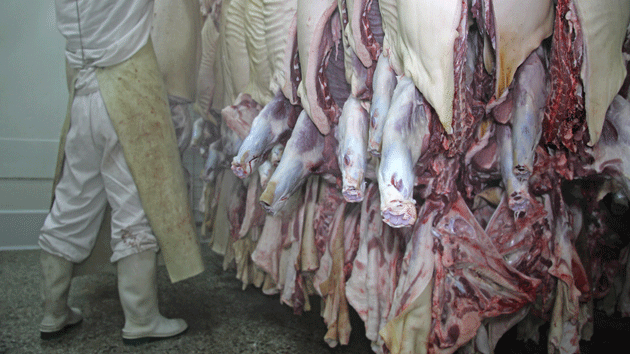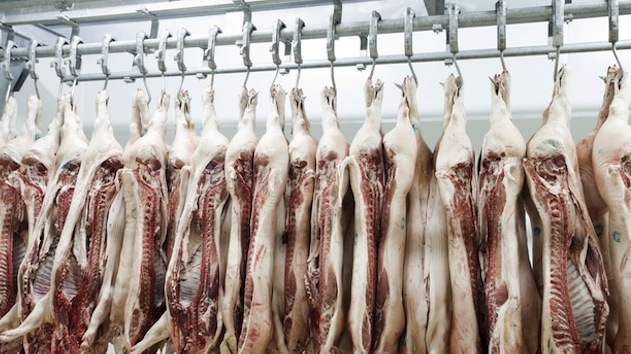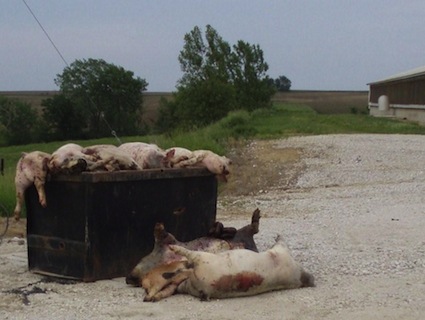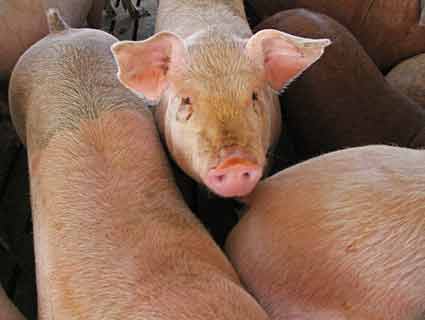
brianislavpudar/Shutterstock
In 2004, Elsa Murano stepped down from her post as chief of the US Department of Agriculture division that oversees food safety at the nation’s slaughterhouses. Two years later, she joined the board of directors of pork giant Hormel, a company that runs some of the nation’s largest slaughterhouses. Murano received $238,000 in compensation for her service on Hormel’s board in 2014 alone.
This is a classic example of the “revolving door” that separates US government regulators from the corporations they regulate. It’s hardly the most shocking thing I gleaned from the whistleblower-protection group Government Accountability Project’s recent exposé of conditions at three hog slaughter facilities associated with Hormel. But it’s interesting to think about in light of GAP’s allegations, found in sworn affidavits filed by four USDA inspectors stationed in Hormel-owned plants. Three of the inspectors chose to remain anonymous; the fourth, Joe Ferguson, gave his name.
Their comments focus on three Hormel-associated plants, which are among just five hog facilities enrolled in a pilot inspection program run by the USDA. In the regular oversight system, USDA-employed inspectors are stationed along the kill line, charged with ensuring that conditions are as sanitary as possible and that no tainted meat ends up being packed for consumption. In the pilot program, known as HIMP (short for Hazard Analysis and Critical Control Points-based Inspection Models Project), company employees take over inspection duties, relegating USDA inspectors to an oversight role on the sidelines.
What’s more, the HIMP plants get to speed up the kill line—from the current rate of 1,100 hogs per hour to 1,300 hogs per hour, a jump of nearly 20 percent. The five plants rolled out the new inspection system around 2002, USDA spokesperson Aaron Lavallee said. That’s when Murano, now on the Hormel board of directors, ran the USDA’s Food Safety and Inspection Service. If the privatization-plus-speedup formula sounds familiar, it’s because the USDA ran a similar experimental program for chicken slaughter for years. After much pushback by workplace and food safety advocates and media attention (including from me), the USDA decided not to let poultry companies speed up the kill line when it opened the new system to all chicken slaughterhouses last year (though it did green-light turkey facilities to speed up the line from 51 to 55 birds per minute).
All four affidavits offer blistering critiques of the hog version of the pilot program. Three themes run through them: (1) company inspectors are poorly trained and prepared for the task of overseeing a fast-moving kill line involving large carcasses; (2) company-employed and USDA inspectors alike face pressure from the company not to perform their jobs rigorously; and (3) lots of unappetizing stuff is getting through as the result of (1) and (2).
The testimony of Inspector 3, affidavit here, is full of choice nuggets, though not of the sort you want to sample before lunch. Here are a few:
- “Not only are plant supervisors not trained, the employees taking over USDA’s inspection duties have no idea what they are doing. Most of them come into the plant with no knowledge of pathology or the industry in general.”
- “Food safety has gone down the drain under HIMP. Even though fecal contamination has increased under the program (though the company does a good job of hiding it), USDA inspectors are encouraged not to stop the line for fecal contamination.”
- “HIMP was initially designed for the kill of young, healthy animals. This hasn’t always been the case. A lot of the animals the plant has killed were too old. Some also had different diseases. They didn’t even slow down the line for the diseased carcasses.”
- “The company threatens plant employees with terminations if they see them condemning too many carcasses or carcass parts.”
For its part, Hormel insists that “food safety is our top priority and we have been a leader in the production of safe, quality food for more than 100 years,” as Rick Williamson, Hormel’s manager of external communications, wrote in an email. “In addition to the USDA inspectors at the facility, there are Hormel Foods employees trained to the standards of the USDA conducting the additional inspections,” he continued. “We’ve found this allows the USDA inspectors better perspective and more flexibility to monitor activity and identify any issues.” As for food safety concerns, he added that “our facilities consistently meet or perform better than published USDA microbiological performance standards.” But he didn’t respond to my request for data to back that claim up, or for commentary on charges of poor training and intimidation of inspectors. But he did add a plug for the privatized inspection and faster kill lines enjoyed by three Hormel-associated plants: “The HIMP program places more accountability on the company, and we welcome that responsibility.”
The USDA’s Food Safety and Inspection Service, the agency that runs the inspection program, is standing behind HIMP too. USDA spokesperson Aaron Lavallee pointed to a November 2014 FSIS report that, he said, “shows that the food safety outcomes at the pilot facilities are on par with those operating under other inspection systems.” The report concluded that there’s “no reason to discontinue HIMP in market hog establishments.”
Meanwhile, the pilot inspection program will continue running as is, confined to five slaughterhouse and not expanding to include others, Lavallee said. Before expanding, he added, “the agency would first need to conduct a risk assessment to determine whether doing so would have a significant positive public health impact, and then engage in the rulemaking process, which can be lengthy.”
However, the USDA’s and Hormel’s rosy assessment of HIMP presents a stark contrast to a scathing 2013 report from yet another USDA agency, the Office of the Inspector General, which found HIMP plants—which it did not name—made up three of the top 10 US hog plants earning the most food safety and animal welfare citations in the period of fiscal years 2008 to 2011. Moreover, by far the most-cited slaughterhouse in the United States over that period was in the program—it drew “nearly 50 percent more [citations] than the plant with the next highest number.” The OIG also concluded that that the Food Safety and Inspection Service “did not provide adequate oversight” of HIMP over its first 15 years, and as a result, “HIMP plants may have a higher potential for food safety risks.”
Ted Genoways, who in 2012 wrote a harrowing account in Mother Jones of what accelerated line speeds have meant for workers slaughterhouse workers, rejects Hormel’s sunny assessment. Genoways’ reporting, later expanded into the superb 2014 book The Chain, focused on the Quality Pork Processors plant in Austin, Minnesota, which supplies its meat solely to Hormel and is one of the three Hormel-associated plants among the five in HIMP. He recently told Food Safety News, “Yes, I think the line speeds [at the HIMP plants] are too fast. When you see the workers on the line say the speeds are too fast, the inspectors say the lines are too fast, the suppliers at the farm level say the lines are too fast, there’s such a unanimity of opinion that I don’t think you can come to any other conclusion.”
Well, not quite unanimous. The USDA’s Food Safety and Inspection Service, of course, continues to defend the pilot program. But then there’s its cozy ties to industry—in addition to Murano’s leap to Hormel, FSIS’s then-chief of staff flew the coop to the National Turkey Federation in 2011, and another high official bolted to work for meat processor OSI Group just this month. Given the tasty meat industry opportunities that evidently await the USDA’s food safety administrators, I take FSIS’s defense of the HIMP program in the face of these sworn statements with about as much salt as you might find in a slice of Hormel’s signature product, Spam.

















